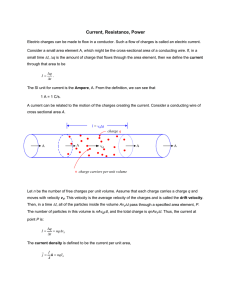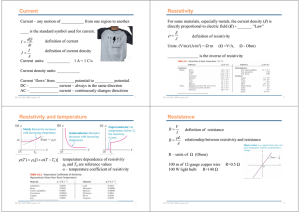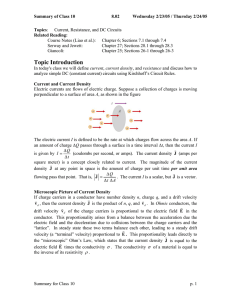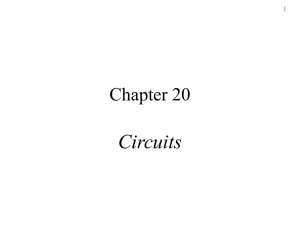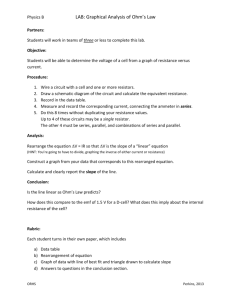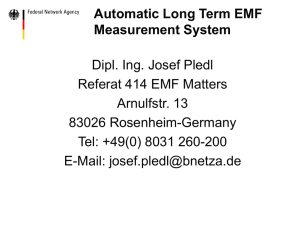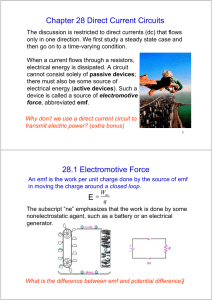phy ch 28 - wbm
advertisement
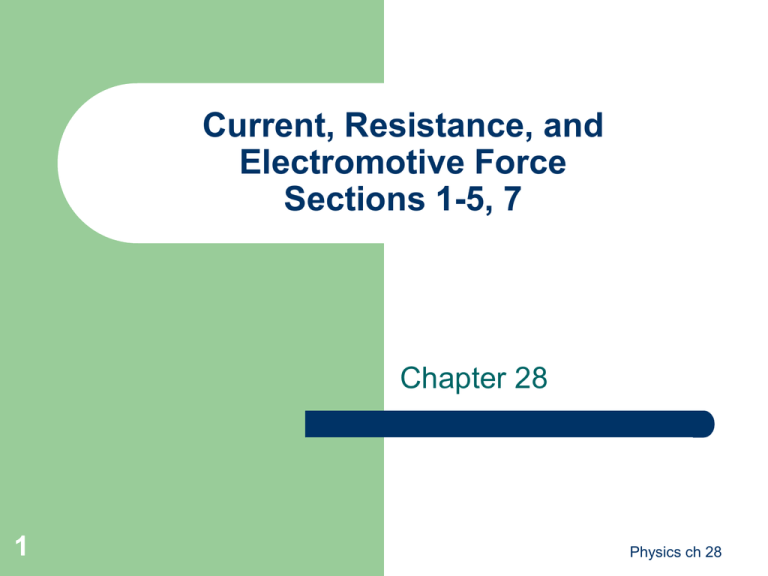
Current, Resistance, and Electromotive Force Sections 1-5, 7 Chapter 28 1 Physics ch 28 Current Movement of charges Scalar quantity Amount of charge transferred per unit time Q I t 2 Measured in amperes or amps 1A = 1 C/s Physics ch 28 Traditional current direction 3 Current flows in the direction that positive charge would flow. It is impossible to experimentally determine which charges are moving. We know that the electrons are actually moving in the opposite direction of current flow, but we keep with tradition. Physics ch 28 Drift velocity 4 Speed of the moving particles. n particles per unit volume are moving in a conductor with speed v. In a time t, each particle moves vt. If the conductor has a cross sectional area A, then the number of particles in a given section during a given time interval is nAvt. Physics ch 28 Drift velocity If each particle has a charge q, the total charge moving through the volume in a given time interval is Q = nqvAt. Q I nqvA t 5 Physics ch 28 Current density Current per unit cross-sectional area I J nqv A 6 Physics ch 28 Resistivity Ratio of electric field to current density E J 7 Big resistivity means that a big E field is needed to cause a given current density, Or that a small E field will cause a small current density Physics ch 28 Resistivity For metals, increases with temperature. T 0 1 T T0 8 For semiconductors, it decreases with temperature. For superconductors it drops suddenly as temperature decreases. Physics ch 28 Resistance Related to resistivity. Often more useful, because it uses total current, not current density. It also uses potential difference instead of E field. Measured in ohms 1 W = 1 V/A R 9 l A Physics ch 28 Ohm’s Law Very important V IR 10 Physics ch 28 Temperature dependence RT R0 1 T T0 11 Physics ch 28 Resistors 12 Circuit elements designed to have a specific resistance. Used to control current. Physics ch 28 Circuits 13 We need a complete circuit to have a steady current. Charge moves in the direction of decreasing potential energy – like rolling downhill. We need to have a device to move the charge back uphill – like the pump in a fountain. Physics ch 28 Electromotive force 14 What makes the charge move from lower to higher potential. Abbreviated emf – say each letter. Batteries Solar cells Generators Physics ch 28 Circuits 15 Contain resistors, sources of emf, and possibly other circuit elements. The algebraic sum of the potential differences around the path is zero. In a simple loop, the current is the same everywhere. Physics ch 28 Sources of emf Maintain a constant potential difference, or voltage, regardless of the current flowing through them. Have positive and negative terminals. – The potential is higher at the positive terminal. E V 16 Physics ch 28 Internal resistance Real sources of emf have some internal resistance to current flow. So, V E Ir E Ir IR E I Rr 17 Physics ch 28 Example on page 632 18 Look at schematic drawings of circuits. Physics ch 28 Kirchoff’s loop rule The sum of the voltages around a loop is zero. Choose a current direction and draw it on the diagram. It’s OK if you’re wrong. – 19 If at the end we get negative current, then the direction was wrong. No big deal. Physics ch 28 Kirchoff’s loop rule 20 If we go across a battery from – to +, we add the voltage. + to – we subtract it. Always subtract IR from a resistor See example on page 635 Physics ch 28 Power Work done per unit time, measured in watts. 1 W is 1 J/s 1 A is 1 C/s 1 V is 1 J/C (1A)(1V) = 1 J/s P IV 21 Physics ch 28 Power Using Ohm’s law, V = IR P I IR PI R 2 22 V P V R 2 V P R Physics ch 28 Power output of emf source P IV IE I r 2 23 Physics ch 28 Power input of emf source P IV IE I r 2 24 Physics ch 28 Physiological effects of currents 25 Nervous system is electrical Currents as low as 1 mA can disrupt the nervous system enough to cause death by fibrillation. Larger currents through the heart may actually be safer – the heart is temporarily paralyzed and has a better chance of restarting with a normal heartbeat Physics ch 28


